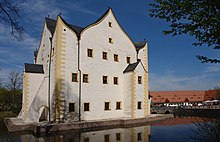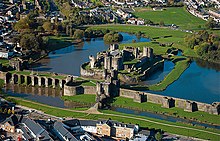Water castle



A water castle[a][dubious ] is a castle whose site is largely defended by water.[2] It can be entirely surrounded by water-filled moats (moated castle) or natural waterbodies such as island castles in a river or offshore.[dubious ] The term comes from European castle studies, mainly German Burgenkunde, but is sometimes used in English-language popular science books and websites,[3][4] and is mentioned in other more academic works.[5] When stately homes were built in such a location, or a Wasserburg was later rebuilt as a residential manor, the German term becomes Wasserschloss, lit. "water palace/manor".
Description[]
Forde-Johnston describes such a site as "a castle in which water plays a prominent part in the defences."[2][clarification needed] Apart from hindering attackers, an abundant supply of water was also an advantage during a siege.[citation needed] Topographically, such structures are a type of low-lying castle.[citation needed] Such a castle usually had only one entrance, which was via a drawbridge and that could be raised for protection in the event of an attack.[citation needed] To some extent these water castles had a fortress-like character.[clarification needed][citation needed]
There is a further distinction between:
- castles that are protected by artificial water-filled moats or man-made ponds, i.e. a moated castles
- castles whose primary means of protection is from natural water bodies such as river courses, or which stand on islands or peninsulas in a natural marshland, pond, lake or sea. Island castles and marsh castles are such examples.[citation needed]
Legacy[]
In many places in Central Europe castles that had formerly been fortified changed their role or were converted over the course of time so that they became largely representational and residential buildings. The characteristic moats thus lost their original security function, but were retained in some cases as an element of landscaping. Today, in monument conservation circles, they are often described as burdensome, cost-intensive "historic legacies" because of the water damage caused to their foundations. As a result, many moats around castles in Germany have been drained, or more rarely filled, especially since the 1960s.
In Germany, the Wasserburgroute or "Water Castle Route" has been established in the triangle formed by the cities of Aachen, Bonn and Cologne which links 120 castles and palaces.[6][7]
Examples[]
Austria[]
- Franzensburg
Baltic[]

- (Arrasch)
- Trakai Island Castle
Belgium[]

- Wijnendale Castle
Czech Republic[]
Denmark[]
Finland[]
- Kajaani Castle
- Olavinlinna
France[]
Please notice that in French "", literally 'water castle', means water tower.
Germany[]








Baden-Württemberg[]
Bavaria[]
- Brennhausen
- Irmelshausen
- Kleinbardorf
- Mespelbrunn Castle
Berlin[]
- Köpenick Palace
- Spandau Citadel
Brandenburg[]
- Plattenburg in the Prignitz
Bremen[]
Hamburg[]
Hesse[]
- in Friedewald
- near
Lower Saxony[]
- Fallersleben Castle
- Hülsede Water Castle
- Lütetsburg
- Osterburg
- Schelenburg
- Wendhausen Castle
- Wolfsburg Castle
Mecklenburg-Vorpommern[]
- Schwerin Castle
North Rhine-Westphalia[]
- Benrath House in Düsseldorf
- Burgau Castle
- Gimborn Castle
- in Bochum
- Morsbroich Castle in Leverkusen
- Moyland Castle in Bedburg-Hau
- Nordkirchen Palace
- Rheydt Palace
- Vischering Castle
- Wilkinghege Water Castle in Münster
- Wittringen Castle in Gladbeck
Rhineland-Palatinate[]
- Alte Burg (Koblenz)
Saarland[]
- Gustavsburg in Homburg
- near Illingen
Saxony[]
- Moritzburg Castle
- Hainewalde Water Castle
Saxony-Anhalt[]
- Calvörde Castle
- Köthen Castle
- Reinharz Water Castle
Schleswig-Holstein[]
- Eutin Castle
- Glücksburg Castle
Thuringia[]
Greece[]
- Bourtzi
- Methoni Castle
Hungary[]
- Sárvár Castle
- Tokaj Castle (ruined)
Italy[]
- Castello Estense
- Castello di Sirmione
- in a broad way, Venice Arsenal
Japan[]

- Imabari Castle
- Nakatsu Castle
- Takamatsu Castle
Lebanon[]
Netherlands[]

- Cannenburgh Castle
- Hoensbroek Castle
- Muiderslot
- Loevestein
- Ammersoyen Castle
- Kasteel Radboud
- Brederode Castle
Portugal[]
Slovakia[]
- Parič Castle (ruined)
- Šintava Castle (ruined)
- Štítnik Water Castle
- Vranov Castle (vanished)
Slovenia[]
Sweden[]

- Älvsborg Fortress
- Bollerup
- Dybäck Castle
- Ellinge Castle
- Gåsevadholm Castle
- Gripsholm Castle
- Häckeberga Castle
- Kalmar Castle
- Krageholm Castle
- Krapperup Castle
- Kronoberg Castle
- Kulla Gunnarstorp Castle
- Landskrona Citadel
- Malmö Castle
- Maltesholm Castle
- Örebro Castle
- Örup Castle
- Osbyholm Castle
- Skabersjö Castle
- Stegeborg Castle
- Strömsholm Palace
- Tosterup Castle
- Trolle-Ljungby Castle
- Trolleholm Castle
- Vadstena Castle
- Vaxholm Fortress
- Vegeholm Castle
- Vibyholm Castle
- Viderup Castle
- Vittskövle Castle



Romania[]
- Făgăraş Castle
- Oradea fortress
Switzerland[]
- Bottmingen Castle
- Chillon Castle
- Hagenwil Castle
- Hallwyl Castle
- Wörth Castle
- Wyher Castle
Turkey[]
- Kızkalesi (castle), formerly Gramvoussa (Greek) and Gorygos (Armenian)
United Kingdom[]
England[]
- Bodiam Castle
- Caister Castle
- Herstmonceux Castle
- Kenilworth Castle[8]
- Leeds Castle
Scotland[]
- Caerlaverock Castle
- Castle Stalker
- Eilean Donan
Wales[]
- Caerphilly Castle[8]
- Beaumaris Castle
Notes[]
References[]
Citations[]
- ^ Gothein 2014, pp. 22, 52, etc.
- ^ Jump up to: a b Forde-Johnston, James L. (1979). Great Medieval Castles of Britain. The Bodley Head. p. 163. ISBN 0370302362. Retrieved 20 July 2014.
... Caister is based on the Wasserburg of the Rhine area in Germany. Wasserburg means literally 'water castle' and denotes a castle in which water plays a...
- ^ Kaufmann J.E. & Kaufmann H.W. 2004, p. 229.
- ^ 12 Wonderful Water Castles at theworldgeography.com. Retrieved 12 March 2021.
- ^ Proceedings of the Suffolk Institute of Archaeology and History 2005, p. 44.
- ^ Water castle route at achen-tourismus.de. Retrieved 12 March 2021.
- ^ Water Castles Route at nrw-tourism.com. Retrieved 12 March 2021.
- ^ Jump up to: a b Fry 1980, p. 89.
General[]
- Suffolk Institute of Archaeology and History (2005). Proceedings of the Suffolk Institute of Archaeology and History, Vol. 41, Part 1. Suffolk Institute of Archaeology and History.
- Fry, Plantagenet Somerset (1996). Castles of Britain and Ireland: The Ultimate Reference Book. David & Charles.
- Gothein, Marie Luise Schroeter and Walter P. Wright (2014). A History of Garden Art. Cambridge: CUP.
- Kaufmann, J. E. and H.W. Kaufmann (2004) The Medieval Fortress: Castles, Forts and Walled Cities of the Middle Ages. Cambridge, MA: Da Capo.
External links[]
| Wikimedia Commons has media related to Water castles. |
- Castles by type
- Water castles



